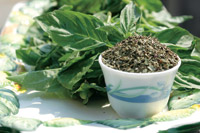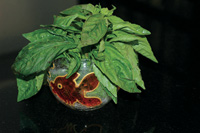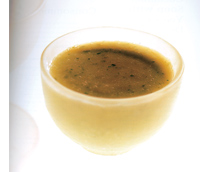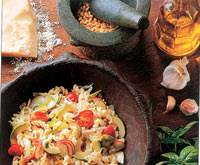


|
Basil The Royal Herb 
Basil is used in many cuisines. The sweet, herbal bouquet is a wonderful touch to any number of dishes and is often used as a staple in salad dressings and soups.
Basil, also known as Albahaca, St. Joseph�s Wort, and Sweet Basil, is a bright green, leafy plant, part of the mint family. The word Basil is derived from the Greek word for �King�, and is even today often called �The King of Herbs� by culinary pundits. There are two varieties of the Basil leaf; one with black-purple leaves and the other with variable leaves. Both varieties are native to India, and to a lesser extent Africa and the Mediterranean, but are grown today primarily in the United States, Egypt, and the Mediterranean region. Basil is widely used in many cuisines, especially Italian, where it is often paired with tomatoes and cheeses. The sweet, herbal bouquet is a wonderful touch to any number of dishes and is often used as a staple in salad dressings and soups.
It is prominently featured in varied cuisines throughout the world including Italian, Thai, Vietnamese and Laotian. The plant tastes somewhat like anise, with a strong, pungent, sweet smell. Basil is very sensitive to cold, with best growth in hot, dry conditions. Basil is most commonly recommended to be used fresh, and in cooked recipes, is generally added at the last moment, as cooking destroys the flavour quickly. The fresh herb can be kept for a short time in plastic bags in the refrigerator, or for a longer period in the freezer, after being blanched quickly in boiling water. Place fresh leaves in a dry jar with a pinch of salt, and cover with olive oil. The dried herb also loses most of its flavour, and what little flavour remains tastes very different, with a weak coumarin flavour, like hay. Basil is also sometimes used with fresh fruit and in fruit jams and sauces � in particular with strawberries, but also raspberries or dark-colored plums. Arguably the flat-leaf basil used in Vietnamese cooking, which has a slightly different flavour, is more suitable for use with fruit.
Chilled Cucumber Basil Soup
Ingredients:
To garnish:
Method:
Basil and Pasta Salad
Ingredients:
For the dressing
Method:
|
|
|

Home Page
About the mag
Subscribe
Advertise
Contact Us

 If you are buying fresh herbs, then they should be carefully washed, wrapped in a damp paper towel, then placed in a plastic bag and stored in the butter compartment of the refrigerator up to four days. On the other hand, dried herbs will maintain freshness for six months to a year, so the smallest possible sized container should be bought if any particular herb is not used often.
If you are buying fresh herbs, then they should be carefully washed, wrapped in a damp paper towel, then placed in a plastic bag and stored in the butter compartment of the refrigerator up to four days. On the other hand, dried herbs will maintain freshness for six months to a year, so the smallest possible sized container should be bought if any particular herb is not used often.

